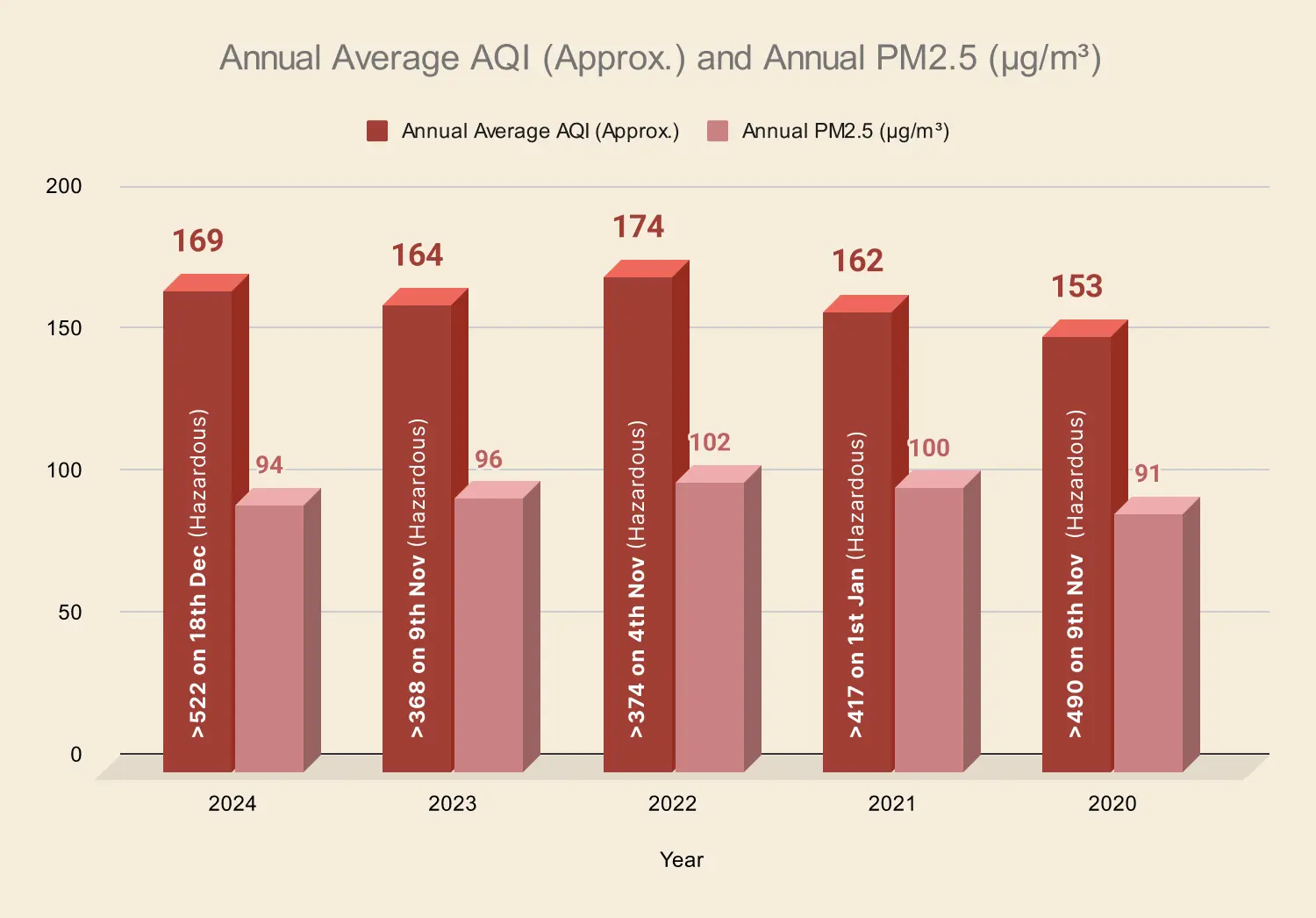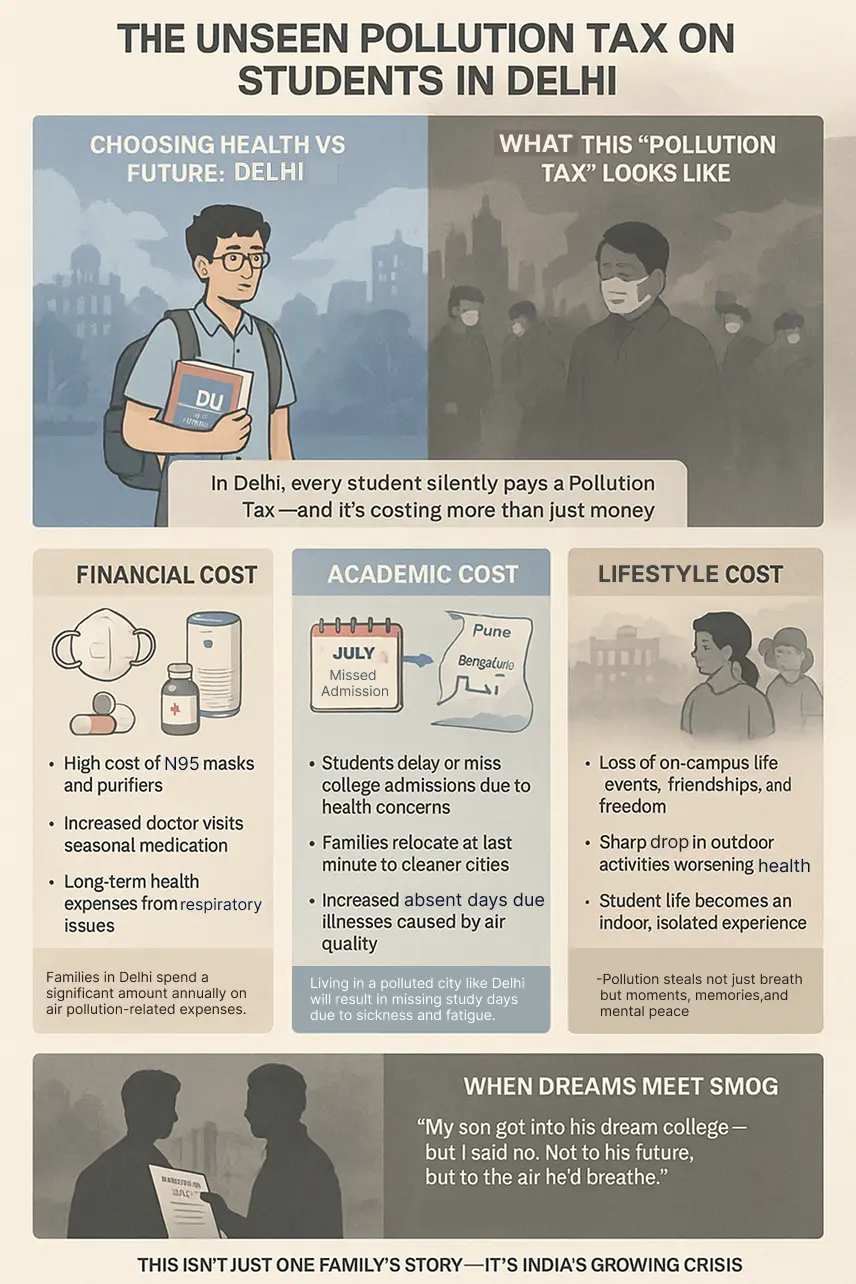Imagine, after years of preparation and dedication, you are the only one selected in the prestigious university after continuous 3 failures, and your father said “NO” due to the air pollution of that city? All of your self-esteem goes down, and new episodes of depression occur. What will you do in this situation? This same situation has happened to a student who wanted to take admission in Delhi University, and luckily, he cracked the CUET and secured a seat at Hansraj College, but his dream was vetoed, not by grades or finances, but by the air he would have to breathe in Delhi. It means that over Hansraj College, Delhi pollution is overpowering!
And this is not a hypothetical scenario because it is the heartbreaking reality for a student from Chandigarh, whose father recently made the painful decision to decline his admission to Hansraj College, citing Delhi’s notorious air pollution. This single, personal story posted on Reddit has ripped open a conversation that thousands of families are having in hushed tones: Is the prestige of a Delhi University degree worth the gamble on a young person’s health?
Understanding the DU Admission Dream: Hansraj College, One in a Lakh Opportunity
To understand the weight of this decision, one must first understand what is being given up. Delhi University is not just an institution; it’s a legacy. For decades, it has been a magnet for the nation’s brightest minds.
The University of Delhi is a major attraction for not just students from Delhi, Haryana, Bihar or other Indian states, because international students also study in this university. This year, around 3.05 lakh+ applicants registered through CSAS-UG to complete on around 70,000+ seats in a total of 69 colleges of DU. It means this student from Chandigarh has competed against over 3.05 lakh+ students and managed to grab 1 seat. Furthermore, Hansraj College is one of the most prestigious colleges in India. It shows the competition is fierce, making a confirmed seat in a top-tier college like Hansraj an incredible achievement.
For these students, DU represents more than just a degree; it represents upward mobility, exposure, and a pathway to a global career, all nurtured in the heart of the nation’s capital. But here the question arises as if only a single student parent is concerned about air quality in Delhi among 3.05 lakh+ students?
A Parent’s Dilemma: Hansraj College or Delhi Pollution — Should Education Come at the Cost of Health?
But this vibrant dream is now colliding with an invisible, insidious wall: Delhi’s air pollution. The story of the student from Chandigarh is a stark indicator of a terrifying new trend where aware, informed parents are starting to see Delhi not as a city of opportunity, but as a health hazard.
This awareness is both a boon and a bane.
It’s a boon because these parents understand the scientifically-proven risks associated with breathing toxic air—chronic respiratory illnesses, asthma, reduced lung function, and even long-term cardiovascular damage. They are protecting their children from years of potential suffering.
But it’s a bane because this knowledge forces them to sacrifice a life-changing opportunity that families who are less aware of the pollution risks might take without a second thought. They are caught in an impossible dilemma: protect their child’s lungs or secure their future?
Is Delhi Really That Polluted? Yes—and Here’s the Data
Is that father right? Is Delhi’s air pollution really more powerful than the opportunity to study at a top college like Hansraj College? You might be asking yourself the same question—because in Delhi, air quality isn’t just a concern, it’s a crisis. For those living outside the city, the phrase “Delhi pollution” might sound distant or exaggerated. But is it really that bad?
Let’s look at the hard data from AQI.in’s historical records to understand how serious the situation truly is.

Delhi AQI Levels – Last 5 Years Overview
| Year | Annual Average AQI (Approx.) | Highest AQI Level Recorded (Peak Winter) | Annual PM2.5 (µg/m³) |
| 2024 (YTD) | 169 (Unhealthy) | >522 on 18th Dec (Hazardous) | 94 µg/m³ |
| 2023 | 164 (Unhealthy) | >368 on 9th Nov (Hazardous) | 96 µg/m³ |
| 2022 | 174 (Unhealthy) | >374 on 4th Nov (Hazardous) | 102 µg/m³ |
| 2021 | 162 (Unhealthy) | >417 on 1st Jan (Hazardous) | 100 µg/m³ |
| 2020 | 153 (Unhealthy) | >490 on 9th Nov (Hazardous) | 91 µg/m³ |
(Note: Annual averages can be misleading. While the yearly average falls in the ‘Unhealthy’ or ‘Very Unhealthy’ category, the real danger lies in the winter months (October-January) where the AQI consistently stays in the ‘Severe’ and ‘Hazardous’ categories, often exceeding 400-500 for days on end. The WHO’s safe guideline for PM2.5 is an annual average of 5 µg/m³, a level Delhi exceeds by more than 15-20 times.)
The answer is an unequivocal yes. Living in Delhi means exposing a young, developing body to air quality that is hazardous for a significant portion of the year. This isn’t just about a persistent cough; it’s about forcing a lifestyle of compromise—staying indoors, avoiding sports, and the constant, unseen battle being fought inside the body’s respiratory and circulatory systems.
What is the Unseen “Pollution Tax” on Students in Delhi?
In India, every parent faces a difficult dilemma—choosing between their children’s health and their future. On one hand, air pollution looms like a silent, walking monster; on the other, in a world where competition exists at every step, choosing opportunity hubs like Delhi becomes an increasingly difficult decision. Beyond the direct health impact, there is a hidden “pollution tax” that every student in Delhi pays:

- Financial Cost: Expenses on high-quality masks, air purifiers for rooms, and frequent doctor visits. Not just this—taking admission in Delhi means more health problems due to air pollution.
- Academic Cost: Students have to select courses in other cities or even countries. Besides, in this case, the father said no in mid-July, the academic session 2025 is about to start, and the student has to struggle to find another university. Living in a polluted city like Delhi also results in missed study days due to sickness and fatigue.
- Lifestyle Cost: DU colleges are not just known for their education and teaching system, but also for their vibrant campus life, including festivals, sports, management events, department activities, or even simply sitting on the college lawns with friends.
The story of the father and son as choosing health over Hansraj College Delhi pollution is not an isolated incident. It is the canary in the coal mine. It signifies a profound shift where the environment is no longer a background factor but a primary, non-negotiable determinant in the biggest decisions of our lives.
As more parents become armed with real-time AQI data, we are forced to confront a deeply unsettling question:
Are we creating world-class institutions in cities that are becoming unfit for our brightest to live in?
Disclaimer: Some images in this blog have been generated using AI.